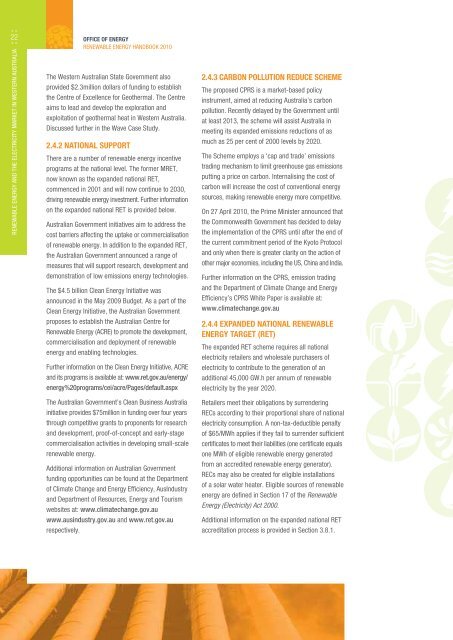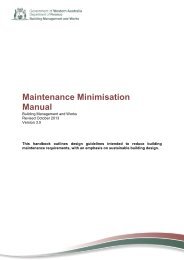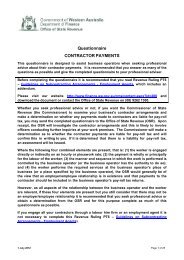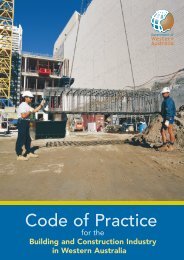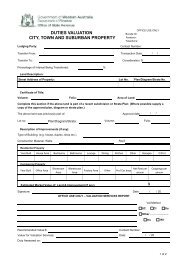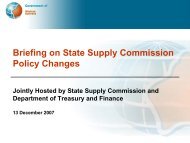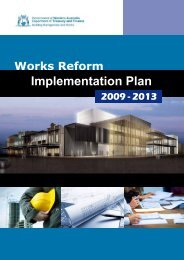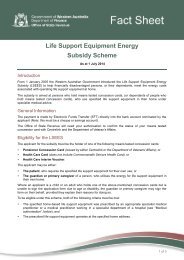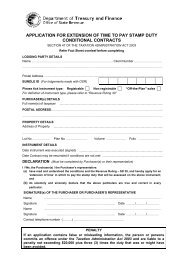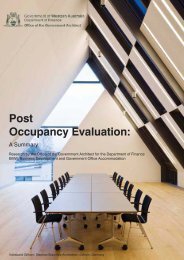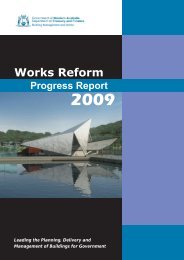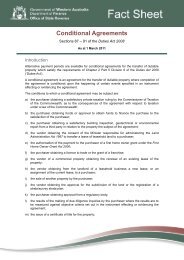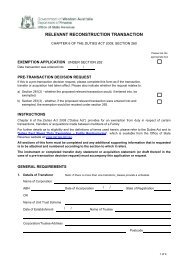Renewable Energy Handbook 2010 - Department of Finance - The ...
Renewable Energy Handbook 2010 - Department of Finance - The ...
Renewable Energy Handbook 2010 - Department of Finance - The ...
You also want an ePaper? Increase the reach of your titles
YUMPU automatically turns print PDFs into web optimized ePapers that Google loves.
22RENEWABLE ENERGY AND THE ELECTRICITY MARKET IN WESTERN AUSTRALIAOFFICE OF ENERGYRENEWABLE ENERGY HANDBOOK <strong>2010</strong><strong>The</strong> Western Australian State Government alsoprovided $2.3million dollars <strong>of</strong> funding to establishthe Centre <strong>of</strong> Excellence for Geothermal. <strong>The</strong> Centreaims to lead and develop the exploration andexploitation <strong>of</strong> geothermal heat in Western Australia.Discussed further in the Wave Case Study.2.4.2 NATIONAL SUPPORT<strong>The</strong>re are a number <strong>of</strong> renewable energy incentiveprograms at the national level. <strong>The</strong> former MRET,now known as the expanded national RET,commenced in 2001 and will now continue to 2030,driving renewable energy investment. Further informationon the expanded national RET is provided below.Australian Government initiatives aim to address thecost barriers affecting the uptake or commercialisation<strong>of</strong> renewable energy. In addition to the expanded RET,the Australian Government announced a range <strong>of</strong>measures that will support research, development anddemonstration <strong>of</strong> low emissions energy technologies.<strong>The</strong> $4.5 billion Clean <strong>Energy</strong> Initiative wasannounced in the May 2009 Budget. As a part <strong>of</strong> theClean <strong>Energy</strong> Initiative, the Australian Governmentproposes to establish the Australian Centre for<strong>Renewable</strong> <strong>Energy</strong> (ACRE) to promote the development,commercialisation and deployment <strong>of</strong> renewableenergy and enabling technologies.Further information on the Clean <strong>Energy</strong> Initiative, ACREand its programs is available at: www.ret.gov.au/energy/energy%20programs/cei/acre/Pages/default.aspx<strong>The</strong> Australian Government’s Clean Business Australiainitiative provides $75million in funding over four yearsthrough competitive grants to proponents for researchand development, pro<strong>of</strong>-<strong>of</strong>-concept and early-stagecommercialisation activities in developing small-scalerenewable energy.Additional information on Australian Governmentfunding opportunities can be found at the <strong>Department</strong><strong>of</strong> Climate Change and <strong>Energy</strong> Effi ciency, AusIndustryand <strong>Department</strong> <strong>of</strong> Resources, <strong>Energy</strong> and Tourismwebsites at: www.climatechange.gov.auwww.ausindustry.gov.au and www.ret.gov.aurespectively.2.4.3 CARBON POLLUTION REDUCE SCHEME<strong>The</strong> proposed CPRS is a market-based policyinstrument, aimed at reducing Australia’s carbonpollution. Recently delayed by the Government untilat least 2013, the scheme will assist Australia inmeeting its expanded emissions reductions <strong>of</strong> asmuch as 25 per cent <strong>of</strong> 2000 levels by 2020.<strong>The</strong> Scheme employs a ‘cap and trade’ emissionstrading mechanism to limit greenhouse gas emissionsputting a price on carbon. Internalising the cost <strong>of</strong>carbon will increase the cost <strong>of</strong> conventional energysources, making renewable energy more competitive.On 27 April <strong>2010</strong>, the Prime Minister announced thatthe Commonwealth Government has decided to delaythe implementation <strong>of</strong> the CPRS until after the end <strong>of</strong>the current commitment period <strong>of</strong> the Kyoto Protocoland only when there is greater clarity on the action <strong>of</strong>other major economies, including the US, China and India.Further information on the CPRS, emission tradingand the <strong>Department</strong> <strong>of</strong> Climate Change and <strong>Energy</strong>Effi ciency’s CPRS White Paper is available at:www.climatechange.gov.au2.4.4 EXPANDED NATIONAL RENEWABLEENERGY TARGET (RET)<strong>The</strong> expanded RET scheme requires all nationalelectricity retailers and wholesale purchasers <strong>of</strong>electricity to contribute to the generation <strong>of</strong> anadditional 45,000 GW.h per annum <strong>of</strong> renewableelectricity by the year 2020.Retailers meet their obligations by surrenderingRECs according to their proportional share <strong>of</strong> nationalelectricity consumption. A non-tax-deductible penalty<strong>of</strong> $65/MWh applies if they fail to surrender suffi cientcertificates to meet their liabilities (one certificate equalsone MWh <strong>of</strong> eligible renewable energy generatedfrom an accredited renewable energy generator).RECs may also be created for eligible installations<strong>of</strong> a solar water heater. Eligible sources <strong>of</strong> renewableenergy are defi ned in Section 17 <strong>of</strong> the <strong>Renewable</strong><strong>Energy</strong> (Electricity) Act 2000.Additional information on the expanded national RETaccreditation process is provided in Section 3.8.1.3-5963079


